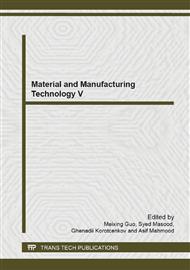[1]
L. Ayed, S. Achour, and A. Bakhrouf, 2011, Application of the mixture design to decolourise effluent textile wastewater using continuous stirred bed reactor, Water SA, 37(1), pp.21-26.
DOI: 10.4314/wsa.v37i1.64102
Google Scholar
[2]
M. Ponraj, K. Gokila and V. Zambare, 2011, Bacterial Decolourization of Textile Dye-Orange 3R, International Journal of Advanced Biotechnology and Research, ISSN 0976-2612, 2(1), pp.168-177.
Google Scholar
[3]
C. Novotny,K. Svobodová, O. Benada , O. Kofron ˇová , A. Heissenberger, W. Fuchs, 2011, Potential of combined fungal and bacterial treatment for color removal in textile wastewater, Bioresource Technology, 102.
DOI: 10.1016/j.biortech.2010.09.014
Google Scholar
[4]
N. Tüfekci, N. Sivri and I. Toroz, 2007, Pollutants of Textile Industry Wastewater and Assessment of its Discharge Limits by Water Quality Standards, Turkish Journal of Fisheries and Aquatic Sciences 7.
Google Scholar
[5]
B. Adinew, (2012)Textile effluent treatment and decolorization techniques – A review. Bulgarian Journal of Science Education, 21(3).
Google Scholar
[6]
A.B. Dos Santos, F.J. Cervantes and J.B. Van Lier, 2007, Review paper on current technologies for decolorization of textile wastewaters: Perspectives for anaerobic biotechnology. Bioresour. Technol, 98: 2369.
DOI: 10.1016/j.biortech.2006.11.013
Google Scholar
[7]
Siti Zuraida M., Nurhaslina C.R. and Ku Halim K. H, 2009, Influence of Agitation, pH and temperature on Growth and Decolorization of Batik Wastewater by Bacteria Lactobacillus Delbruckii, IJRRAS 14(2).
DOI: 10.1109/beiac.2013.6560194
Google Scholar
[8]
Environmental Quality Act 1974 (Act 127), 2010, Regulation, Rules & Orders, International Law Book Services.
Google Scholar
[9]
N.K. Kilic J.L. Nielsen,M. Yuce, and G. Donmez, (2007) Characterization of a simple bacterial consortium for effective treatment of wastewaters with reactive dyes and Cr(VI). Chemosphere, 67: 826.
DOI: 10.1016/j.chemosphere.2006.08.041
Google Scholar
[10]
R.G. Saratale, G.D. Saratale, J.S. Chang and S.P. Govindwar (2011) Bacterial decolorization and degradation of azo dyes: A review. Journal of the Taiwan Institute of Chemical Engineers, 42: 138–157.
DOI: 10.1016/j.jtice.2010.06.006
Google Scholar
[11]
M.B. Kurade, T.R. Waghmode and S. P. Govindwar (2011), Preferential biodegradation of structurally dissimilar dyes from a mixture by Brevibacillus laterosporus. J. Hazard Mater, 192: 1746- 1755.
DOI: 10.1016/j.jhazmat.2011.07.004
Google Scholar


